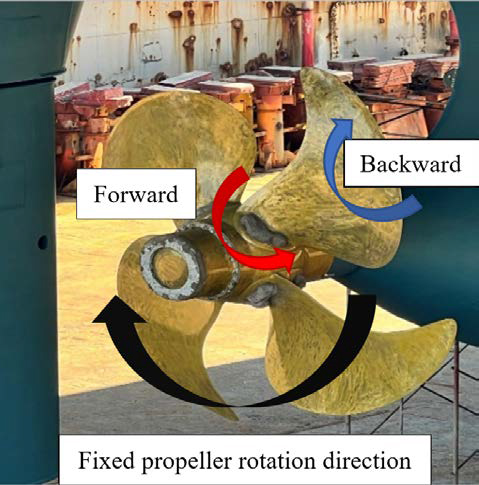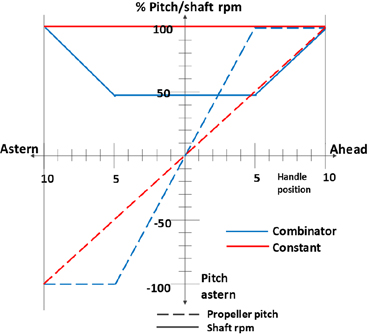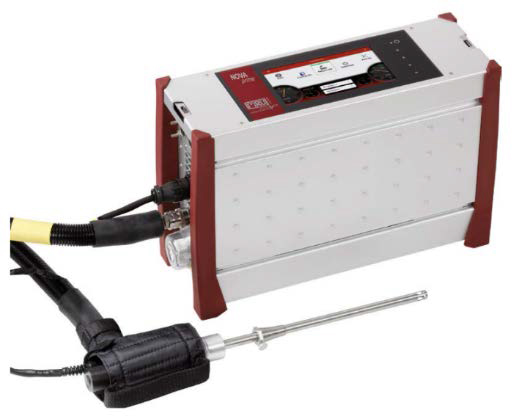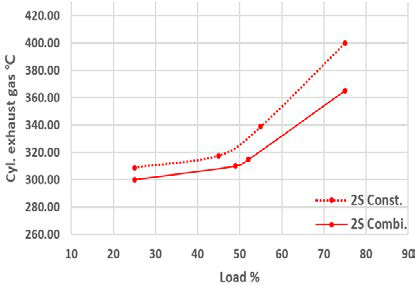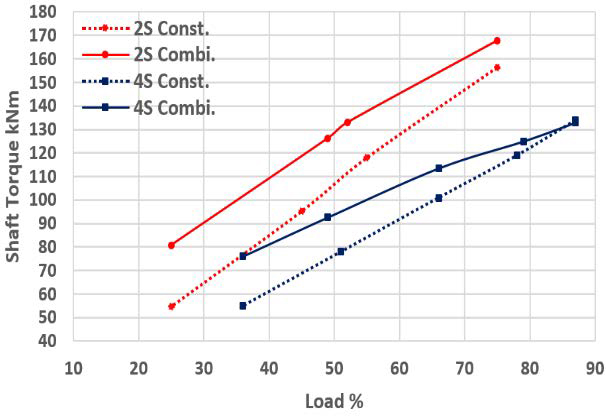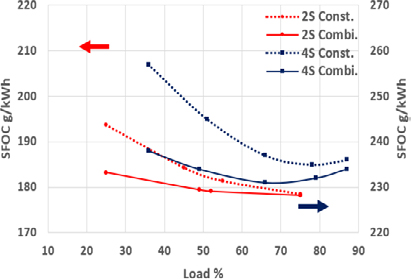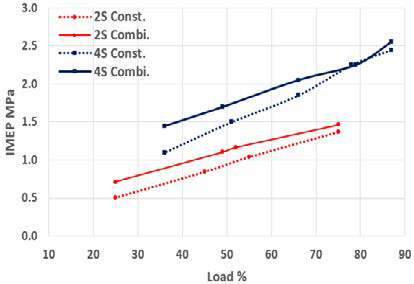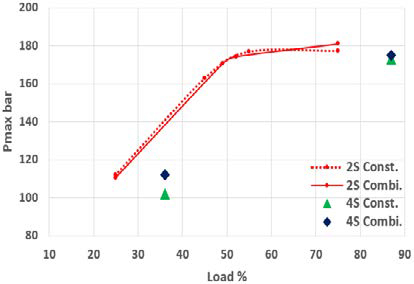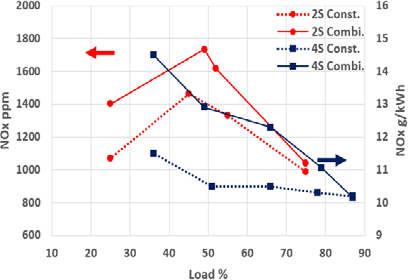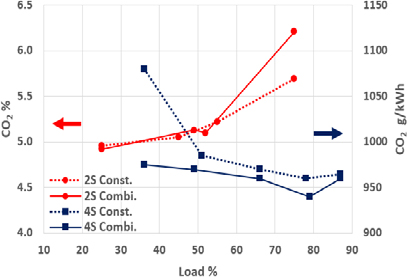
A study on performance and exhaust emission characteristics according to the controllable pitch propeller operation of two-stroke diesel engine in sailing condition
Copyright © The Korean Society of Marine Engineering
This is an Open Access article distributed under the terms of the Creative Commons Attribution Non-Commercial License (http://creativecommons.org/licenses/by-nc/3.0), which permits unrestricted non-commercial use, distribution, and reproduction in any medium, provided the original work is properly cited.
Abstract
The engine performance and exhaust gas emissions of a ship equipped with a two-stroke diesel engine and another equipped with a controllable pitch propeller(CPP) were compared in combinator and constant modes under varying engine loads. Baek-kyung, a fishery training ship at Pukyong National University, can operate a (CPP) in combinator and constant modes during sailing. When the propeller's rpm and pitch were changed simultaneously in the two-stroke diesel engine while sailing, and when the rpm was fixed and only the propeller pitch was controlled, the performance and exhaust emissions when the propeller pitch was controlled were compared with those of the four-stroke diesel engine. Both the two- and four-stroke diesel engines exhibited good performance when operating in combinator mode. With regard to nitrogen oxides emissions, the constant mode was generally low; however, the emissions tended to decrease as they increased to a high-load area. It is expected that the performance and exhaust emissions according to the operation mode of the two-stroke diesel engine will serve as basic data reference for improving the efficiency of the two-stroke diesel engine and (CPP).
Keywords:
Performance, Emission, Two-stroke, Diesel engine, Controllable pitch propeller, Nitrogen oxides1. Introduction
Unlike a four-stroke engine, a two-stroke diesel engine is an internal combustion engine that produces one power stroke for each complete cycle of piston movement, consisting of one upward and one downward stroke. Because of its simple design and high power density, this engine is commonly used in ships, generators, and certain vehicles [1].
The operation of a two-stroke diesel engine follows the basic principle of completing an operational cycle using only an upward compression stroke and a downward power stroke. During this process, exhaust gases are expelled and fresh air is introduced through a process called scavenging [2]. Owing to these characteristics, a two-stroke diesel engine can provide high power density through simple mechanisms; however, it also presents environmental challenges, such as higher emissions, compared to a four-stroke engine.
The shipping industry plays a crucial role in global trade, accounting for more than 80% of the global trade volume. However, this significant economic contribution is accompanied by substantial environmental challenges, particularly air pollution [3]. Nitrogen oxides (NOx) emitted by ships have been identified as major pollutants with harmful effects on both human health and the environment [4]. In response to these concerns, the International Maritime Organization (IMO) has introduced increasingly stringent regulations, including Tier III standards that require significant reductions in NOx emissions from marine engines [5].
Two-stroke diesel engines, which are widely used in large ships owing to their high efficiency and reliability, face particular challenges in meeting emission standards [6]. The characteristics of these engines, such as low-speed operation and long strokes, contribute to the formation of high NOx levels during combustion [7]. A solution to address this problem is to combine a CPP with a two-stroke diesel engine.
CPP can be applied to two-stroke diesel engines for a variety of applications. A CPP can implement a position control system together with a side thruster, and can be equipped with a shaft power generation system [8]. It can be flexibly adapted to wide engine loads. In addition, because the engine rotation and thrust can be adjusted while the propulsion efficiency is high, the fuel consumption rate can be reduced. Therefore, it can be applied to offshore plants and exploration ships to respond according to the operational characteristics [9]. However, owing to its special structure, the initial purchase and maintenance costs are high. A CPP maintains optimal engine speed in a diesel engine, and the characteristics of exhaust gases may vary depending on the operation method of the CPP.
A study found that the NOx emission rate under a medium load was lower in the constant mode than in the combinator mode, and that the CO2 emission rate decreased in the combinator mode depending on the operation mode of the CPP propulsion of the marine four-stroke diesel engine. (Kim & Wang, 2022) [10].
Recent research trends show that research is being conducted toward developing an integrated control system for a two-stroke diesel engine and CPP, analyzing vibration characteristics, and optimizing fuel consumption [11]. In particular, major engine manufacturers such as MAN Energy Solutions are developing smart control systems that combine digital technology to further improve the efficiency of engine-propeller systems [12]. As environmental regulations are strengthened, new technical challenges are emerging, such as combining dual-fuel engines and controllable-pitch propellers and applying emission-reduction technologies [13].
Accordingly, integrated optimization of the engine-propeller system, performance prediction according to operating conditions, and the establishment of an eco-friendly driving strategy are suggested as major future research directions.
Figure 1 shows a CPP. The speed of the ship can be adjusted as the angle changes, according to the value at which the propeller blade is programmed. In addition, as it is possible to change the blade angle of the propeller, a reverse system for the main engine is not required.
The main engine of T/S Baek Kyung of Pukyong National University is equipped with an EGR system and was manufactured for the first time in Korea using the S35ME-B engine type. T/S Baek Kyung uses a two-stroke diesel engine equipped with an EGR system and a CPP. Performance and emissions data of diesel engine related to CPP operation from an actual voyage are difficult to find and are valuable.
The main engine of the T/S Baek Kyung is a two-stroke diesel engine; however, its propulsion can be changed by changing the angle of the CPP without a reversing system.
Figure 2 shows a conceptual diagram of the changes in the combinator and constant modes.
In the combinator mode, the rpm of the main engine and the pitch of the propeller are changed together by the programmed value.
In Figure 2, the blue line shows the change in combinator mode. In the combinator mode, the shaft rpm starts at approximately 50% of the initial value, does not change until handle position 5, and becomes slightly steeper after handle position 5. The propeller pitch starts at 0%, becomes 100% at handle position 5, and remains fixed at 100% after handle position 5.
In the constant mode, the rpm of the main engine is maintained at a set value, and the pitch value is changed. In Figure 2, the red line is in the constant mode, the shaft rpm is fixed at 100%, and the propeller pitch value changes depending on the handle position.
T/S Baek Kyung is a ship in which a CPP is connected to a two-stroke diesel engine, and there is little research data. The purpose of this study is to compare the performance according to the CPP operation method and the characteristics of exhaust emissions in a two-stroke diesel engine with the performance according to the CPP operation method in a four-stroke diesel engine.
2. Experimental Equipment and Methods
2.1 Ship and Main Engine
Table 1 lists the specifications for T/S Baek Kyung and T/S Sae Dong Baek. T/S Baek Kyung is a fishery training ship with a gross tonnage of 3,998 tons, a length of 97 m, and a breath of 15.4 m. The service speed is 15.27 knots and the propeller is CPP.
Table 2 shows specifications of the main engine installed on the T/S Baek Kyung. The main engine, model 5S35ME-B9.5, is a two-stroke engine with a bore of 350 mm and a stroke of 1,550 mm. It has a rated rotation speed of 167 rpm and a maximum output of 3,475 kW. SFOC is 173.0 g/kWh ± 5% tolerance. Additionally, an EGR system is installed for NOx reduction.
The main engine and propulsion in the T/S Baek Kyung have three operating modes: combinator, constant, and separate, as described in the Introduction. When operating on a bridge, the combinator mode was set to the default.
Table 3 shows specifications of the main engine installed on the T/S Sae Dong Baek. The main engine, model HIMSEN H32/40P, is a four-stroke engine with a bore of 320 mm and a stroke of 400 mm. It has a rated rotation speed of 750 rpm and a maximum output of 3,500 kW.
2.2 Exhaust Gas Measuring Device
The device used for exhaust gas sampling is shown in Figure 3.
Table 4 lists the specifications of NOVA Prime. To verify the accuracy of the measuring instrument, a span gas test was conducted and the results are listed in Table 3. This was confirmed to be within the accuracy range and the experiment was performed.
2.3 Experiment Method
Table 5 presents each experimental mode. 2S refers to two-stroke diesel engine. The fuel used in the experiment was low-sulfur fuel MGO. The measurements were made at 25%, 49%, 52%, and 75% with the main engine in combinator mode on sailing. When sailing in constant mode, the main engine was operated and measurements were made at 25%, 45%, 55%, and 75%. While monitoring the data of the diesel engine in the engine monitoring system (EMS), the stable data value for 10 minutes among the data stored in the integrated control monitoring system (ICMS) was averaged. T/S Baek Kyung does not have a reduction gear and the propeller pitch is expressed in %.
Table 6 presents each experimental mode. 4S refers to four-stroke diesel engine. The fuel used in the experiment was low-sulfur fuel MGO. The measurements were made at 36%, 51%, 66%, 78%, and 87% engine loads with the main engine in combinator mode. When sailing in constant mode, the main engine was operated and measurements were made at 36%, 49%, 66%, 79%, and 87% engine loads. The data were averaged by collecting 20 minutes of data through the ICMS under each operating condition. T/S Sae Dong Baek has a reduction gear on the main engine shaft. The propeller pitch is expressed in degrees.
3. Experiment Results and Considerations
3.1 Impact of Operating Mode on Engine Performance
The solid and dotted lines represent the combinator and constant modes, respectively. The red and blue lines represent the two- and four-stroke diesel engines, respectively.
Figure 4 shows the exhaust gas temperature according to each load in the combinator and constant modes of the two-stroke diesel engine; however, the exhaust gas temperature cannot be compared because it cannot be determined from the exhaust gas temperature data of the four-stroke diesel engine. As listed in Table 5, the combustion efficiency was judged to be high because the rpm of the combinator mode was lower than that of the constant mode in the two-stroke diesel engine.
Figure 5 shows the torques of the two- and four-stroke diesel engines. The two-stroke diesel engine exhibited a higher torque than the four-stroke diesel engine. This seems to be due to the difference in the operating stroke and the structural differences of the diesel engine.
The torque was higher in combinator mode for both the two- and four-stroke diesel engines. This appears to be because the combustion efficiency was good as the rpm was lower than that of the constant mode.
Figure 6 shows the changes in fuel consumption according to the operation modes of the two- and four-stroke diesel engines.
The fuel consumption was high at low loads and low at high loads in both two- and four-stroke diesel engines. In the case of the two-stroke diesel engine, the difference was approximately 5.42% at 25% engine load to 193.67 g/kWh in constant mode and 183.16 g/kWh in combinator mode. The slope of the fuel consumption per unit power decreased steeply up to 50% of the engine load, and then showed a gentle slope up to 75% of the engine load. This is thought to be due to the optimization of fuel injection timing electronic control and T/C matching in the two-stroke diesel engine, which improves the combustion efficiency as Pmax reaches its peak [15].
In the four-stroke diesel engine, the constant and combinator modes have a fuel consumption difference of approximately 8% at a 36% engine load, with the lowest consumption at approximately 70% to 80% of the main engine load, and then slightly increases again. It is thought that the fuel consumption increases in the case of the four-stroke diesel engine because the thermal efficiency decreases owing to pump loss as the load increases.
Among the methods for operating the CPP in two- and four-stroke diesel engines, the combinator mode showed lower fuel consumption than the constant mode. This difference is significant when considering the shaft torque. As shown in Figure 4 and 5, in constant mode, under low-load conditions, the engine operates at high rpm to maintain the power output, which leads to inefficient torque delivery. This increases the exhaust gas and heat losses owing to excessive rotational speed. However, the combinator mode optimizes both the rpm and propeller pitch, allowing more efficient torque delivery at low rpm, thereby reducing the fuel consumption and minimizing the energy loss [14].
Figure 7 shows the change in the indicated mean effective pressure (IMEP) according to the CPP operation mode of the two- and four-stroke diesel engine. For the two-stroke diesel engine, the slope increased smoothly in both modes. In the case of the four-stroke diesel engine, the slope of the IMEP is steeper than that of the two-stroke diesel engine in both modes, and the difference in the IMEP between the two modes decreases near the rated load of 75-85%, which indicates optimal efficiency.
The higher IMEP values in the combinator mode in the two- and four-stroke diesel engines are thought to be due to the more efficient work being performed in the combinator mode compared to the constant mode, as shown in Figure 5, where the torque is higher in the combinator mode.
Figure 8 shows the maximum explosion pressures of the two- and four-stroke diesel engines according to the CPP operation mode. In the two-stroke diesel engine, at 25% load, there was only a difference of 1.41 bar at 112.0 bar in constant mode and 110.59 bar in combinator mode. The change in maximum explosion pressure increased sharply up to 55% of the engine load and then exhibited a gradual slope thereafter. This graph is similar to the variable injection timing (VIT) technology applied to an existing MC-type diesel engine in the two-stroke diesel engine.
In an MC-type diesel engine, VIT improves thermal efficiency by adjusting the fuel injection point according to the up and down movements of the fuel pump barrel. However, in an ME-type diesel engine, the opening and closing points of the exhaust valve are adjusted using the ELVA valve at low loads, and the fuel injection timing is adjusted using the ELFI valve at high loads to improve the output [15,16].
In the electronic control engine, the fuel injection timing was optimized as an electronic control, such that the combustion efficiency could be increased even at a load lower than the rated load. Beyond approximately 55% engine load, both the combinator and constant modes exhibited similar forms. However, the constant mode, which adjusts only the propeller pitch, shows a slightly lower value than the combinator mode at 75% engine load, As shown in section 2, which is thought to be due to heat and exhaust gas loss because the engine rpm is high at the same load.
The value of the four-stroke diesel engine was found to be only in the low and high-load areas; however, the maximum explosion pressure was almost similar at the high load, and the difference was approximately 10 bar at 36% load. As shown in section 2, the engine rpm is high even at low loads in constant mode; therefore, it is believed that the thermal efficiency is low owing to exhaust gas, heat, and pump loss. However, in a four-stroke diesel engine, the combinator mode can operate at a high maximum explosive pressure, and even when referring to fuel consumption, the engine efficiency is considered to be better than that of the constant mode.
3.2 Effect of Operating Mode on Emission Performance
In terms of emissions, the units of the two- and four-stroke diesel engines differ. The THC value was not obtained from the value measured by the two-stroke diesel engine; therefore, it was not converted into units of g/kWh. This section presents the trend of the graph for each component.
Figure 9 shows the NOx emissions of the two- and four-stroke diesel engines according to the CPP operation mode. In the two-stroke diesel engine, the emissions increased from 25% to 50%, whereas in the two-stroke diesel engine, the THC value could not be measured and expressed quantitatively. However, the PPM concentration increased the load from 25% to 50% and then decreased rapidly beyond 50% engine load. In the two-stroke diesel engine, the NOx concentration tended to decrease as the combustion conditions improved and the maximum combustion pressure was optimized beyond approximately 55% engine load.
In a four-stroke diesel engine, the amount of NOx generated continues to decrease at low loads. In constant mode, NOx concentration decreased by approximately 23% at 25% load for the two-stroke diesel engine, while the amount of g(NOx) reduced by approximately 21% at 36% load for the four-stroke diesel engine. Regarding the trend of NOx emissions, the constant mode is lower than the combinator mode in both the two- and four-stroke diesel engines, which is thought to be due to the short reaction time for NOx formation, because the constant mode operates at a higher rpm than the combinator mode from the low-load area.
Figure 10 shows the CO2 emissions of the two- and four-stroke diesel engines according to the CPP operation mode. In the two-stroke diesel engine, the CO2 concentration gradually increased to approximately 50% engine load and then increased steeply beyond 50%. This was attributed to the improved combustion conditions enabled by the electronic control profile of the two-stroke diesel engine. Additionally, in the two-stroke diesel engine, the difference in CO2 concentration becomes more pronounced in the combinator mode than in the constant mode beyond 50% load, likely owing to the improved engine efficiency and combustion conditions as the rated load approaches.
In a four-stroke diesel engine, the difference in CO2 generation begins to increase at lower loads and decreases at approximately 50% of the engine load. This suggests a lower fuel consumption in the combinator mode when producing the same output at lower loads.
Although a quantitative comparison of these two diesel engines has not yet been performed, their CO2 emissions exhibit different trends. In the two-stroke diesel engine, the combinator mode exhibited a higher CO2 concentration, whereas in the four-stroke diesel engine, the amount of CO2 generated was lower.
4. Conclusion
Comparison of test results in CPP mode showed lower fuel consumption for the two-stroke diesel engine than the four-stroke diesel engine.
- 1) In terms of the average effective pressure, the four-stroke diesel engine is often more effective than the two-stroke diesel engine and is thought to be capable of responding quickly to load fluctuations. Therefore, the four-stroke diesel engine is suitable for small ship engines.
- 2) In terms of performance, it is efficient for both the two- and four-stroke diesel engines to operate the CPP in the combinator mode. It is sometimes necessary to consider using a constant mode according to the operating conditions of the ship.
- 3) In terms of exhaust emissions, it is difficult to compare the two- and four-stroke diesel engines under the same conditions; however, when comparing the trends according to the CPP operation mode, the constant mode showed a lower overall value than the combinator mode. However, it is advantageous for the constant mode to reduce NOx emissions when operating within ports in the ECA.
If the CPP is optimized for small- and mediumsized two-stroke diesel engines, the performance can be expected to improve along with reduction in exhaust emissions.
Nomenclature
| CPP : | controllable pitch propeller |
| CO2 : | carbon dioxide |
| IMEP : | indicated mean effective power |
| ECA : | emission control area |
| EGR : | exhaust gas recirculation |
| MCR : | maximum continuous rating |
| NOx : | nitrogen oxides |
| PPM : | part per million |
| SFOC : | specific fuel oil consumption |
| S.M : | sea margin |
| SMCR : | specific maximum continuous rating |
| THC : | total hydro carbons |
Acknowledgments
This research was supported by Korea Institute of Marine Science & Technology Promotion(KIMST) funded by the Ministry of Oceans and Fisheries(202205686).
Author Contributions
Conceptualization, J. S. Moon and S. C. Hwang; Methodology, J. S. Moon and M. A. Je; Software, J. S. Moon; Formal Analysis, J. S. Moon and M. A. Je; Investigation, J. S. Moon; Resources J. S. Moon; Data Curation, M. A. Je; Writing-Original Draft Preparation, J. S. Moon; Writing-Review & Editing, S. C. Hwang and J. S. Moon; Visualization, J. S. Moon; Supervision, S. C. Hwang, Project Administration, S. C. Hwang; Funding Acquisition, S. C. Hwang.
References
-
P. Tribotte, F. Ravet, V. Dugue, P. Obernesser, N. Quechon, J. Benajes, R. Novella, and D. de Lima, “Two strokes diesel engine - promising solution to reduce CO2 emissions,” Procedia - Social and Behavioral Sciences, vol. 48, pp. 2295–2314, 2012.
[https://doi.org/10.1016/j.sbspro.2012.06.1202]

-
X. He, Q. Tan, Y. Wu, and C. Wei, “Optimization of marine two-stroke diesel engine based on air intake composition and temperature control,” Atmosphere, vol. 13, no. 2, 355, 2022.
[https://doi.org/10.3390/atmos13020355]

-
I. Kostova, V. Nikiforov, C, Pirovsky, and G. Ilieva, “NOx reduction system selection and energy efficiency impact evaluation for ships sailing in restricted areas,” IOP Conference Se-ries: Earth and Environmental Science, vol. 1128, no. 1, 012026, 2023.
[https://doi.org/10.1088/1755-1315/1128/1/012026]

- NOxs (NOx) – Regulation 13. International Maritime Organization, https://www.imo.org/en/OurWork/Environment/Pages/Nitrogen-oxides-(NOx)-%E2%80%93-Regulation-13.aspx, , Accessed November 7, 2024.
- Tier III NOx. WinGD, https://www.wingd.com/en/technology-innovation/environmental-technologies/regulations-solutions/tier-iii-nox/, , Accessed November 7, 2024.
-
S. Zhu, Y. Tang, D. Wang, S. Bai, K. Deng, and G. Wang, “Numerical studies on the flow characteristic of the marine two-stroke engine integrated with the high-pressure exhaust gas recirculation system,” Case Studies in Thermal Engineering, vol. 53, 103958, 2024.
[https://doi.org/10.1016/j.csite.2023.103958]

-
Z. Wang, S. Zhou, Y. Feng, and Y. Zhu, “Research of NOx reduction on a low-speed two-stroke marine diesel engine by using EGR (exhaust gas recirculation)–CB (cylinder bypass) and EGB (exhaust gas bypass),” International Journal of Hydrogen Energy, vol. 42, no. 30, pp. 19337–19345, 2017.
[https://doi.org/10.1016/j.ijhydene.2017.06.009]

-
C. Sui, P. de Vos, D. Stapersma, K. Visser, H. Hopman, and Y. Ding, “Mean value first principle engine model for predicting dynamic behaviour of two-stroke marine diesel engine in various ship propulsion operations,” International Journal of Naval Architecture and Ocean Engineering, vol. 14, 100432, 2022.
[https://doi.org/10.1016/j.ijnaoe.2021.100432]

- Controllable Pitch Propeller (CPP) Vs Fixed Pitch Propeller (FPP), https://www.marineinsight.com/naval-architecture/controllable-pitch-propeller-cpp-vs-fixed-pitch-propeller-fpp/, , Accessed December 7, 2024.
-
S.-A. Kim, and W.-G. Wang, “A study of engine performance and exhaust emission characteristics of CPP propulsion ship with operating mode,” Journal of Power System Engineering, vol. 26, no. 6, pp. 91-100, 2022.
[https://doi.org/10.9726/kspse.2022.26.6.091]

-
R. D. Geertsma, K. Visser, and R. R. Negenborn, “Adaptive pitch control for ships with diesel mechanical and hybrid propulsion,” Applied Energy, vol. 228, pp. 2490-2509, 2018.
[https://doi.org/10.1016/j.apenergy.2018.07.080]

- MAN Engergy solutions, SaCoS 5000, https://www.man-es.com/marine/products/digital-marine-products/sacos-5000-tool, , Accessed December 7, 2024.
-
A. Rempel da Silva, G. C. França, J. C. Ordonez, and C. H. Marques, “Fuel consumption prediction in dual-fuel low-speed marine engines with low-pressure gas injection,” Journal of Energy Resources Technology, vol. 146, no. 12, 2024.
[https://doi.org/10.1115/1.4066058]

- Technical paper, Basic Principles of Ship Propulsion, MAN Marine Engines & Systems, Copenhagen, Denmark, p. 12. 2008.
- H. -K. Jung, J.-G. Kim, and J.-H. Won, Basic Concept of Main Engine Output for Ships and Factors for Output Change, https://www.krs.co.kr/TECHNICAL_FILE/%EC%84%A0%EB%B0%95%EC%9A%A9%20%EC%A3%BC%EA%B8%B0%EA%B4%80%20%EC%B6%9C%EB%A0%A5%EC%9D%98%20%EA%B8%B0%EB%B3%B8%20%EA%B0%9C%EB%85%90%EA%B3%BC%20%EC%B6%9C%EB%A0%A5%EB%B3%80%ED%99%94%EB%A5%BC%20%EC%9C%84%ED%95%9C%20%EC%9D%B8%EC%9E%90.pdf, , Accessed December 7, 2024.
- Pounder, Marine Diesel Engines and Gas Turbine, 8th ed., Seoul, Korea: Dong Myung Sa, 2005 (in Korean).

